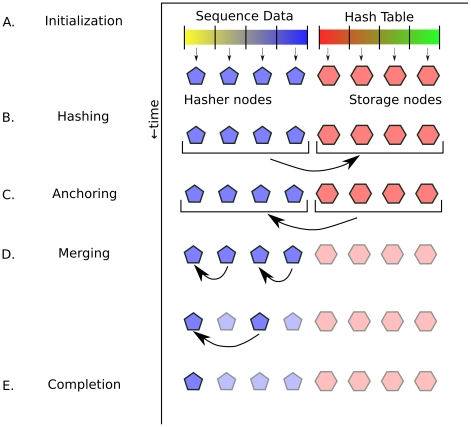Figure 3. Parallel algorithm overview.
Here we show a simplified 8 node example of the parallel Murasaki algorithm. The time axis shows the progression of steps and is not drawn to scale. At A Each hasher node is assigned an equal part of the sequence data (depicted as yellow-blue line), and each storage node is assigned a part of the hash table (depicted as a red-blue line). At B nodes have been divided into “hasher nodes” (shown as blue pentagons) and “storage nodes” (shown as red hexagons). Here hasher nodes act as producers, hashing the input sequence and passing  pairs to the storage nodes which store them in the hash table. At C, the producer/consumer roles are switched such that storage nodes extract matching seed sets from the hash table and send them to hash nodes. Once all matching seed sets have been extracted, the storage nodes are finished and can be terminated (indicated by the lighter coloring in D). At this point each hasher node has an independent anchor tree. Hasher nodes are divided into pairs, with one node sending all of its anchors to the other. These anchors are merged using the normal coalescing algorithm. Once a hasher has finished sending, it can be terminated. Because the number of hasher nodes is halved at each iteration, this merge step finishes in
pairs to the storage nodes which store them in the hash table. At C, the producer/consumer roles are switched such that storage nodes extract matching seed sets from the hash table and send them to hash nodes. Once all matching seed sets have been extracted, the storage nodes are finished and can be terminated (indicated by the lighter coloring in D). At this point each hasher node has an independent anchor tree. Hasher nodes are divided into pairs, with one node sending all of its anchors to the other. These anchors are merged using the normal coalescing algorithm. Once a hasher has finished sending, it can be terminated. Because the number of hasher nodes is halved at each iteration, this merge step finishes in  iterations, where
iterations, where  is the number of hasher nodes. At E only one hasher node remains which handles any additional scoring and filtering of anchors, and outputs the final result.
is the number of hasher nodes. At E only one hasher node remains which handles any additional scoring and filtering of anchors, and outputs the final result.

